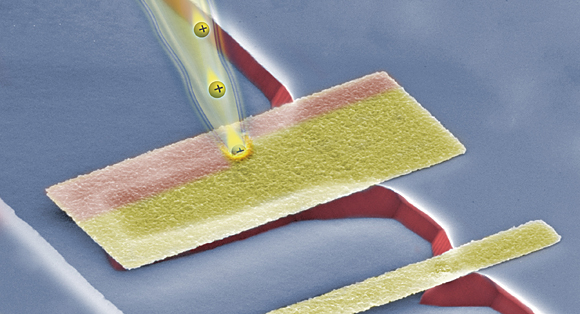3D printing research showcased on top industry innovation list

3D printing has the potential to revolutionize manufacturing processes in a vast number of fields and that includes objects both big and very, very small. The US-based Society of Manufacturing Engineers has highlighted KTH research into 3D printing of nanoscale silicon structures as one of 10 top manufacturing innovations for 2013.
The Society of Manufacturing Engineers (SME) connects researchers with industry experts and other resources worldwide, working to spread manufacturing knowledge among its 24 000 members, representing 21 000 companies worldwide, and the broader manufacturing community in fields from aerospace to energy to medicine.
Every year SME honors 10 new and emerging technologies that have the potential to make an impact on manufacturing processes. The 2013 list includes KTH research into 3D printing of silicon nanostructures used to manufacture photonic and silicon micro-sensor products in low volumes at an affordable cost.
“This new 3D printing method has the potential to greatly increase the innovation power of smaller companies and individual researcher by giving them access they need to smaller numbers of customized silicon micro- and nanostructures,” says Frank Niklaus, the head of the research team and Associate Professor at the Department for Micro and Nanosystems.
Today, producing silicon-based sensors at a micro- or nanoscale requires a full-scale clean-room laboratory, which can cost several million euros. These labs are also rarely suitable for small-scale manufacturing, as the production technology is usually optimised for large production volumes running into hundreds of millions of devices. Many smaller companies, individual researchers and engineers simply can’t afford this type of expensive semiconductor technology infrastructure, Niklaus says.
The technology developed at KTH consists of an additive layer-by-layer process for defining 3D patterns in silicon, using a focused ion beam, followed by silicon deposition. The layered 3D silicon structures are defined by repeating these two steps over and over, with a final etching step in which the excess silicon material is dissolved away. In the team’s vision of the future, the structure would first be designed in a 3D drawing programme then sent to a 3D printer that recreates the structure in silicon, layer by layer from the bottom up.
3D printing tools using materials other than silicon – such as polymers, metals, or ceramics – do already exist, but they are simply not suitable for micro- and nanostructures, according to Niklaus.
Sensors and devices, such as an accelerometer for example, also known as Microelectromechanical Systems (MEMS) are engineered from silicon, the same material used to manufacture integrated circuits. MEMS sensors and devices are used in mobile phones as motion control, in cars and can also be used in industry and in medical technology.
“Giving engineers access to easy specialized manufacturing processes for a wide selection of advanced sensors opens up completely new and creative solutions in fields like medical technology,” Niklaus says. “This means that manufacturing of specially designed sensors for a few patients or tailor-maid applications for industry can be accomplished at a much lower cost.”
The research team including Frank Niklaus, Andreas Fischer, Kristinn Gylfason, Gunnar Malm and Lyubov Belova will meet with manufacturing practitioners in May at SME’s yearly conference in Baltimore in the US with an expected 500 participants worldwide.
“The research team will get a chance to present our technology to people in the manufacturing industry that might actually benefit from it in the future,” Niklaus says. “This kind of exposure is invaluable.”
SME’s 2013 annual manufacturing innovations list
Read more about the innovation list
Read more about the 3D printing research
For more information, contact Frank Niklaus, frank.niklaus@ee.kth.se, 076-216 73 49.
Text Marie Androv
Edited by Benny Ritzén
